Turkey Biscuit Skillet
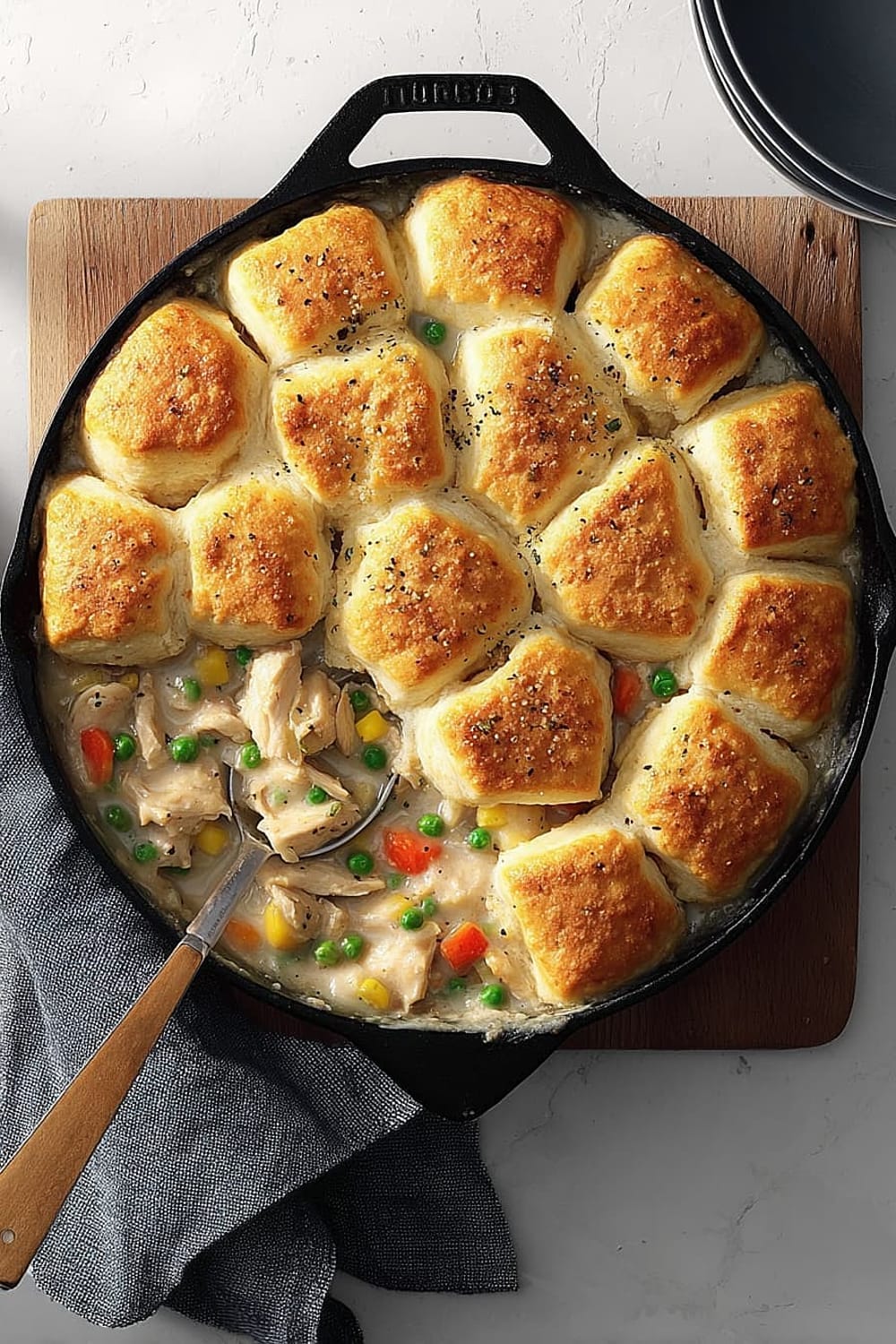
This is basically the ultimate comfort food hack that makes leftover turkey exciting again instead of just sad sandwich filling.
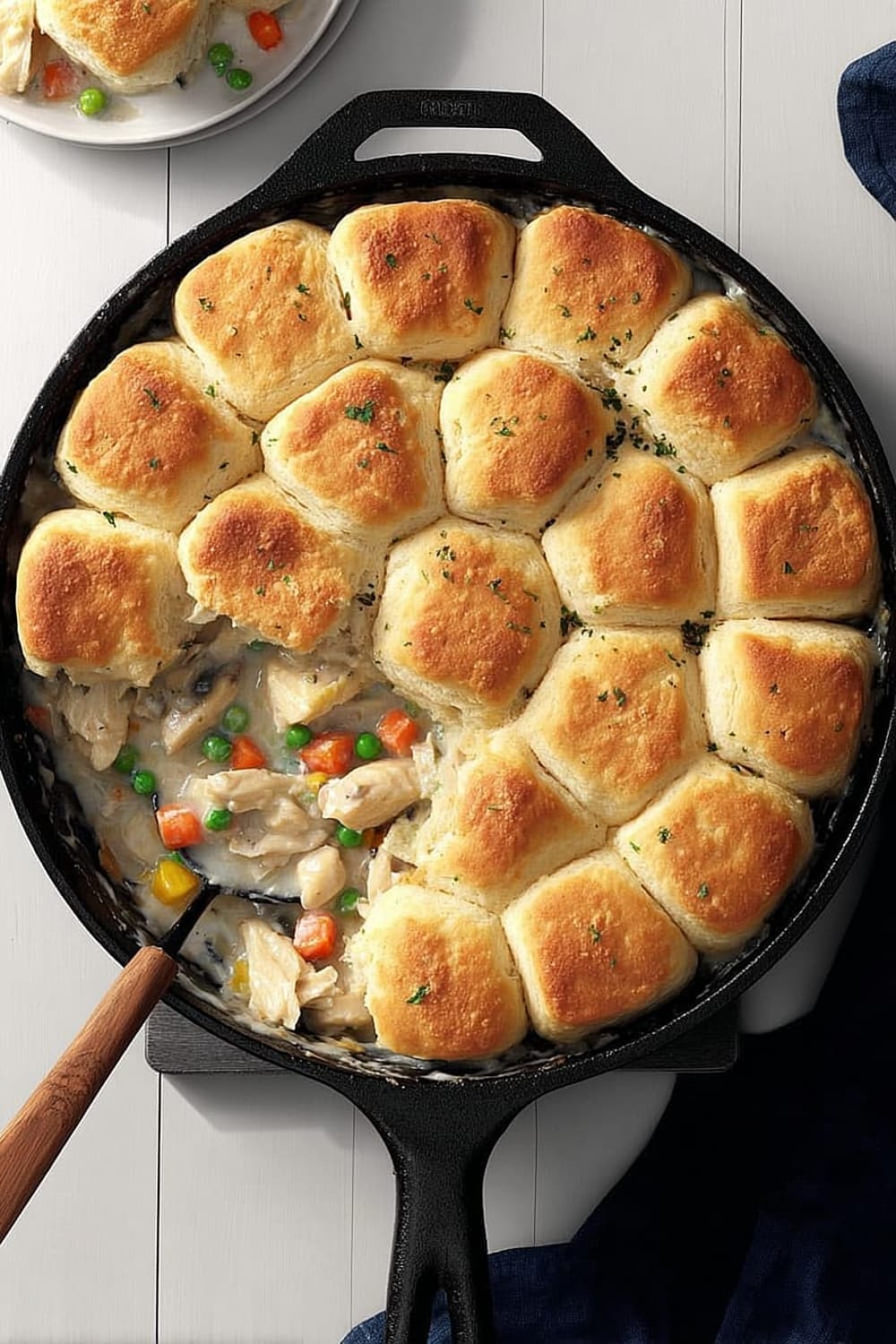
Picture golden, flaky biscuits sitting on top of a bubbling, savory turkey stew that’s been simmering away in your trusty cast iron skillet.
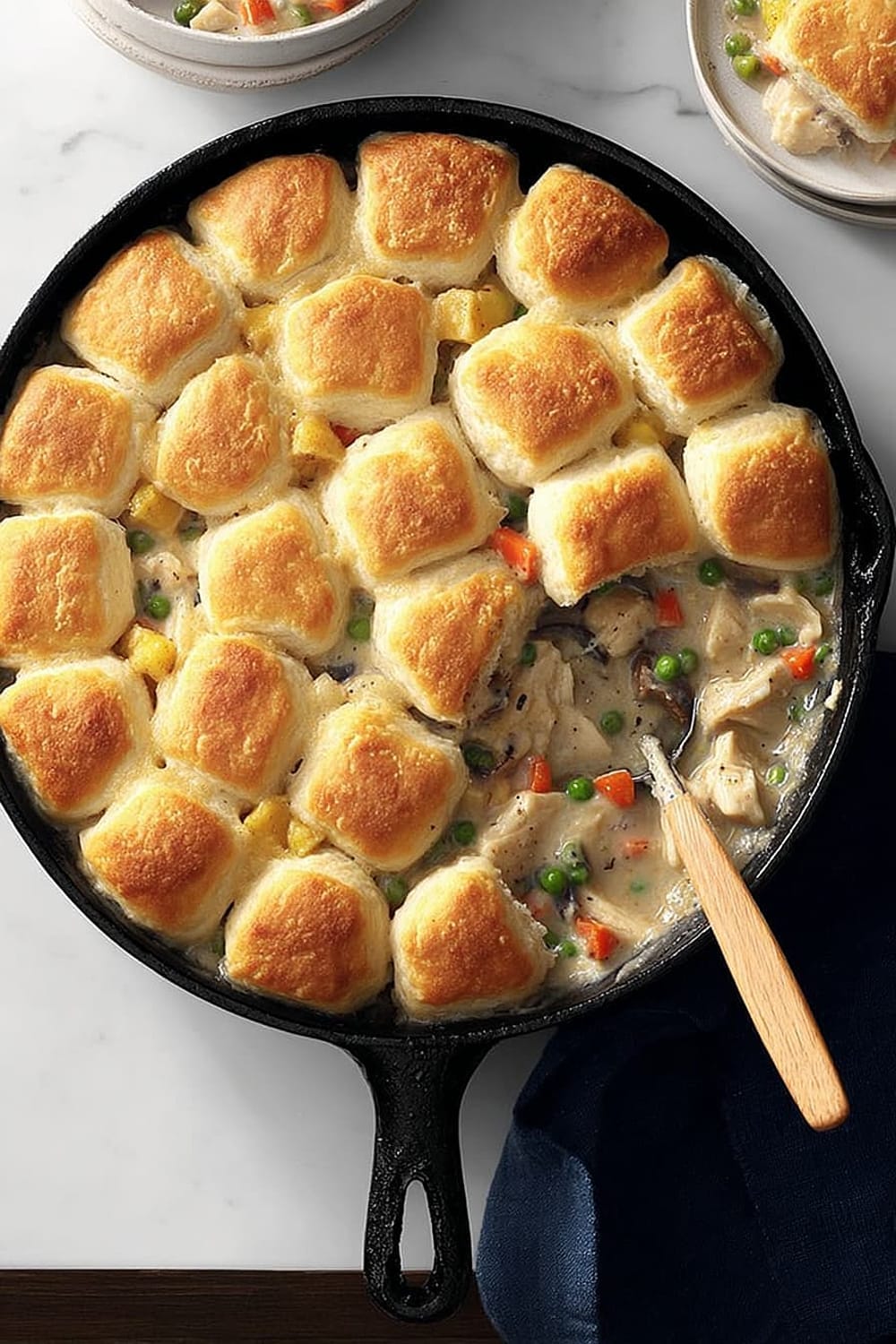
The aroma alone will have everyone wandering into the kitchen asking “What smells so amazing?” while you casually act like this masterpiece didn’t take you all of 30 minutes to throw together.
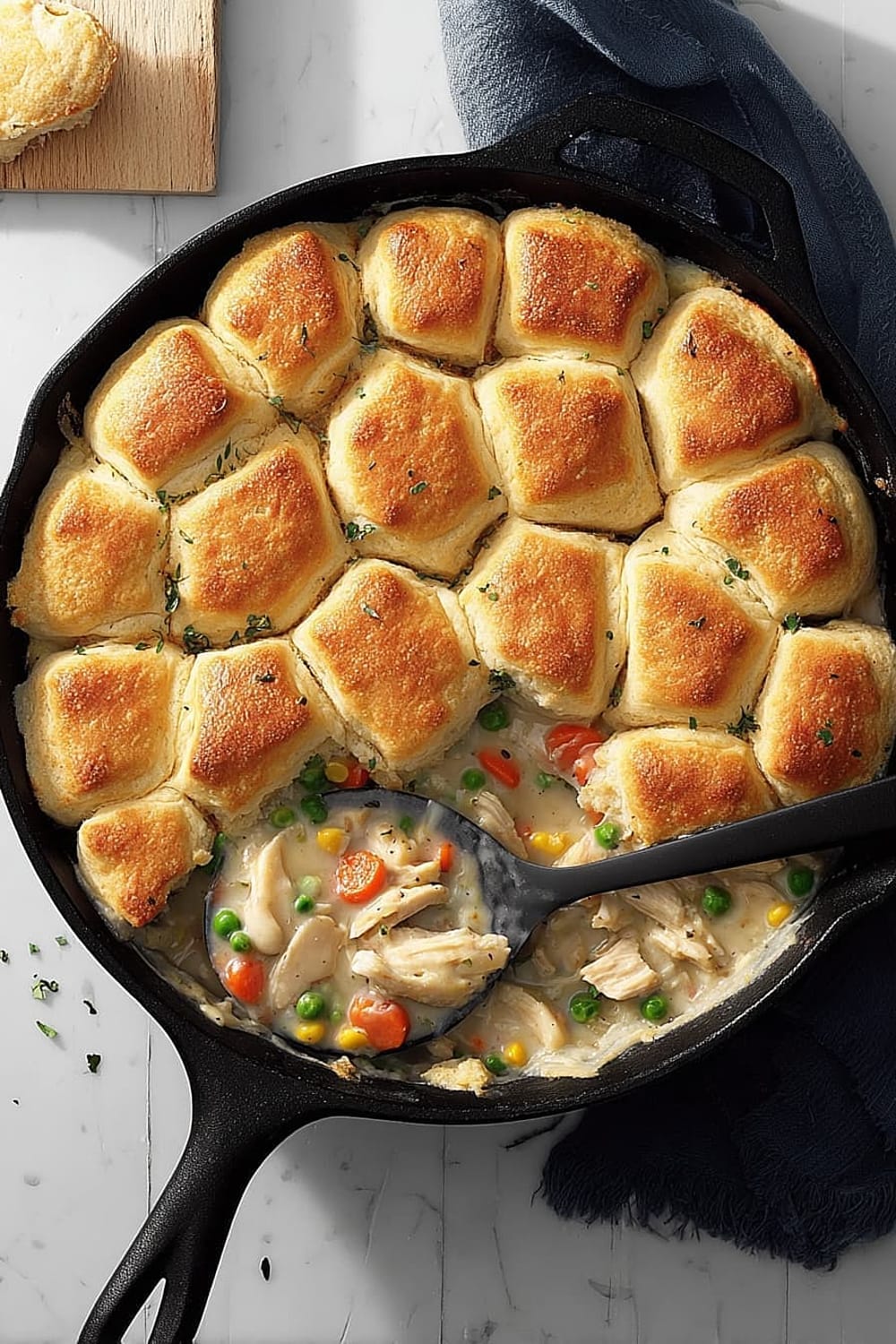
We’re talking tender chunks of turkey swimming in a rich, creamy gravy with colorful peas and carrots, all topped with those perfectly golden biscuits that are crispy on the outside and fluffy on the inside.
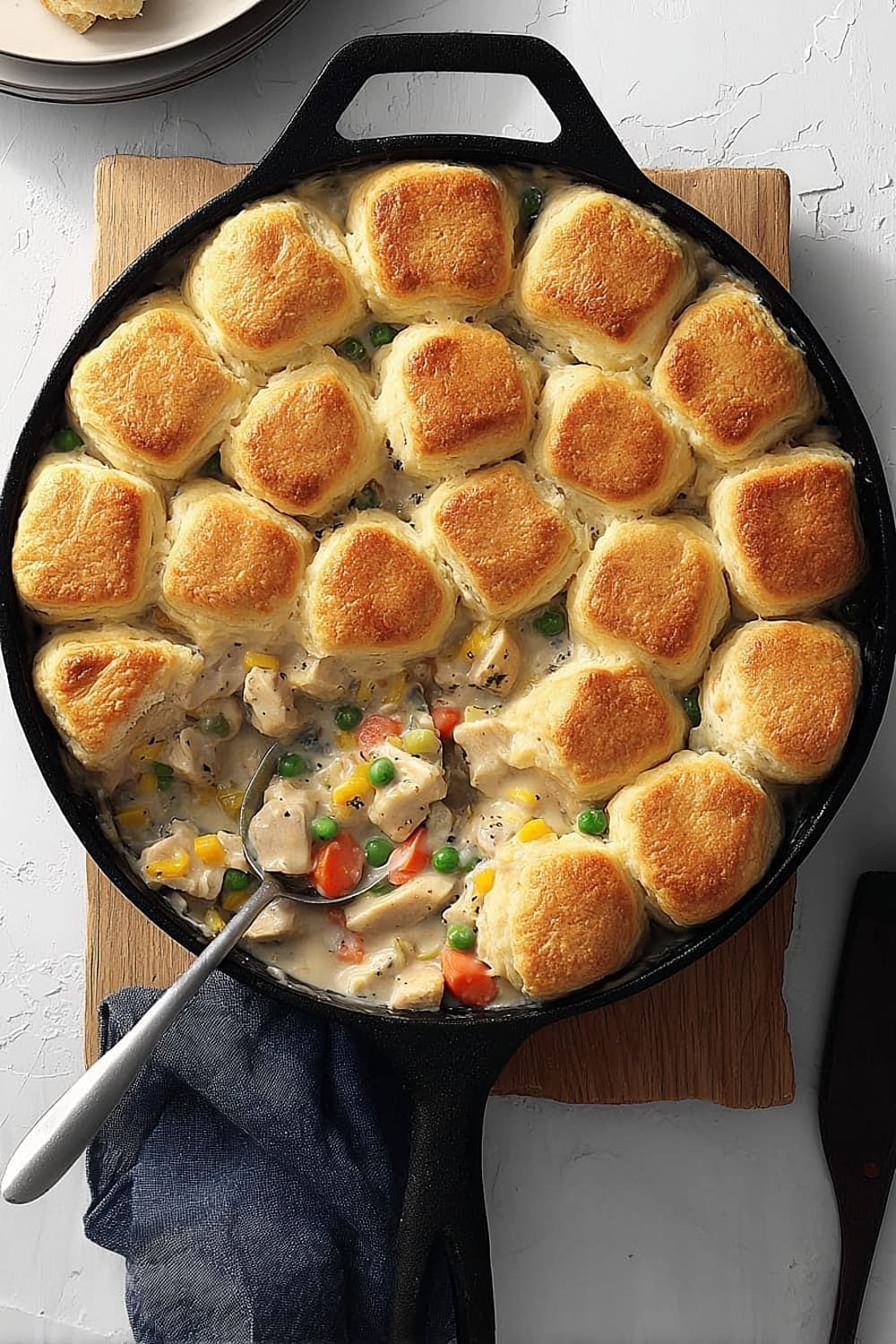
This recipe is proof that you can create something that looks like it came from a fancy farmhouse kitchen without breaking a sweat or your budget.
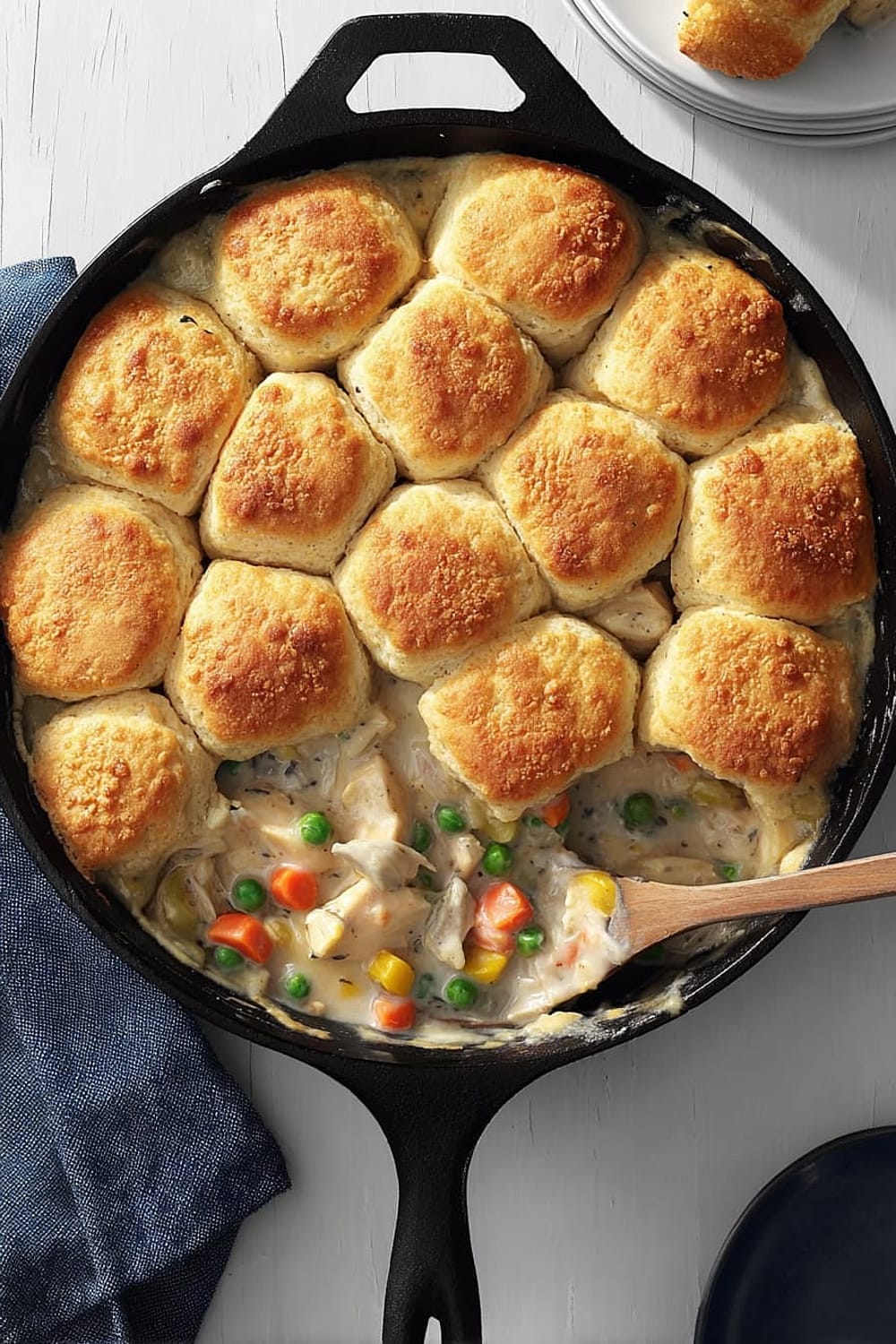
Get ready to become the person everyone asks for the recipe, even though the secret is literally just following these simple steps and having a good ovenproof skillet.
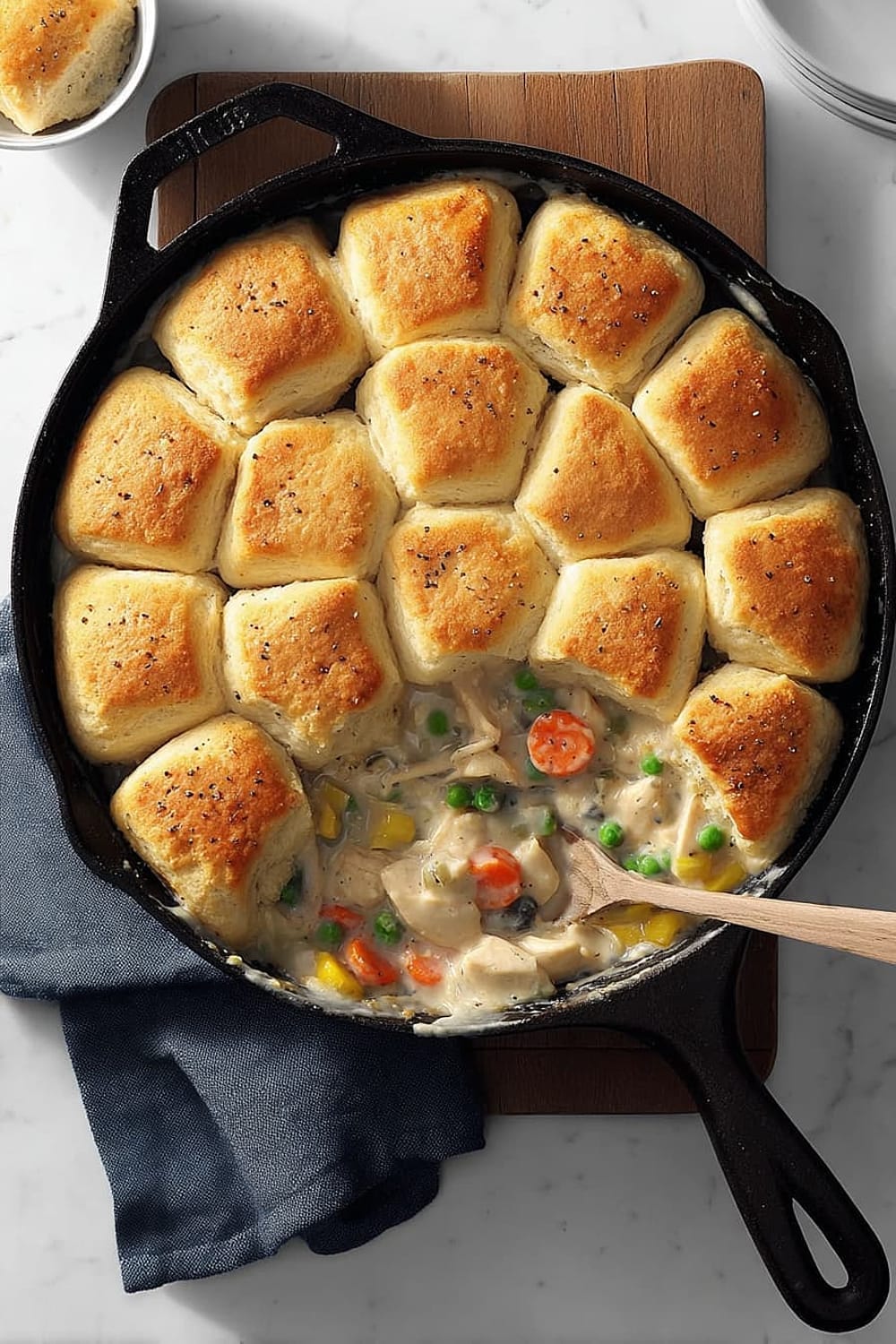
Ingredients
For the Turkey Stew Base
- 1 tablespoon butter
- 1 /3 cup chopped onion
- 1 /4 cup all-purpose flour
- 1 can (10-1/2 ounces) condensed chicken broth, undiluted
- 1 /4 cup fat-free milk
- 1 /8 teaspoon pepper
For the Filling
- 2 cups cubed cooked turkey breast
- 2 cups frozen peas and carrots (about 10 ounces), thawed
For the Biscuit Topping
- 1 tube (12 ounces) refrigerated buttermilk biscuits, quartered
Instructions
Preparation
- 1 Preheat your oven to 400°F (200°C) and ensure your 10-inch cast iron skillet or other ovenproof skillet is ready. The cast iron is ideal here because it distributes heat evenly and goes seamlessly from stovetop to oven.
Create the Gravy Base
- 2 Melt the 1 tablespoon butter in your cast iron skillet over medium-high heat until it’s foaming and fragrant, about 1-2 minutes. You’ll know it’s ready when the butter stops sizzling aggressively.
- 3 Add the 1/3 cup chopped onion to the melted butter and cook, stirring frequently, until the onions become tender and translucent, about 2-3 minutes. Don’t let them brown too much – you want them soft and sweet.
- 4 In a small mixing bowl, whisk together the 1/4 cup all-purpose flour, condensed chicken broth, 1/4 cup fat-free milk, and 1/8 teaspoon pepper until the mixture is completely smooth with no lumps. This slurry will thicken your stew beautifully.
Build the Stew
- 5 Pour the flour mixture directly into the skillet with the cooked onions, stirring constantly with a whisk or wooden spoon. Bring this mixture to a rolling boil while stirring continuously to prevent lumps from forming.
- 6 Continue cooking and stirring for 1-2 minutes until the mixture thickens noticeably and coats the back of your spoon. It should have the consistency of a light gravy.
- 7 Add the 2 cups cubed cooked turkey breast and 2 cups thawed peas and carrots to the thickened gravy. Stir gently to combine and heat through for about 2-3 minutes until everything is warmed and well-coated with the sauce.
Top and Bake
- 8 Arrange the quartered refrigerated buttermilk biscuits evenly over the top of the turkey stew, leaving small gaps between pieces so steam can escape and the biscuits can expand properly.
- 9 Transfer the skillet to your preheated oven and bake for 15-20 minutes until the biscuits are golden brown on top and sound hollow when tapped. The stew should be bubbling around the edges.
- 10 Remove from oven and let rest for 3-5 minutes before serving to allow the gravy to set slightly and prevent burns from the hot skillet.
Recommended Equipment and Kitchen Tools
Essential Tools (for best results)
- Cast iron skillet (10-inch) – This is the star of the show, providing even heat distribution from stovetop to oven and creating that perfect rustic presentation
- Whisk – Critical for creating a smooth, lump-free gravy base that won’t have any flour clumps
- Wooden spoon – Perfect for stirring the stew without scratching your skillet surface
- Small mixing bowl – Essential for combining your flour slurry properly before adding to the hot skillet
Helpful Upgrades
- Digital instant-read thermometer – Ensures your turkey is properly reheated to 165°F (74°C) for food safety
- Silicone spatula – Great for scraping every bit of that delicious gravy from your mixing bowl
- Oven mitts with extended cuffs – Extra protection when handling that hot cast iron skillet
Nice-to-Have Options
- Kitchen scale – For more precise measurements if you’re scaling the recipe up or down
- Fine-mesh strainer – Handy if you want to strain your broth for an ultra-smooth gravy base
Recipe Variations and Dietary Modifications
Gluten-Free Adaptation
- Replace all-purpose flour with 2 tablespoons cornstarch or 1/4 cup gluten-free flour blend
- Use gluten-free biscuits from the refrigerated section or make homemade almond flour biscuits
- Ensure your chicken broth is certified gluten-free (most condensed broths are, but always check)
- Cooking time remains the same, but gluten-free biscuits may brown slightly faster
Dairy-Free Modifications
- Substitute vegan butter or olive oil for the regular butter
- Replace fat-free milk with unsweetened almond milk or oat milk
- Use dairy-free biscuits or make your own using plant-based milk and vegan butter
- The texture will be slightly less rich but equally delicious
Vegetarian/Vegan Version
- Replace turkey with 2 cups cubed firm tofu, tempeh, or plant-based chicken strips
- Use vegetable broth instead of chicken broth for a completely plant-based dish
- Add 1 teaspoon poultry seasoning to mimic traditional turkey flavors
- Include diced mushrooms for extra umami and meaty texture
Low-Carb Modifications
- Skip the flour and use 2 tablespoons cream cheese to thicken the sauce instead
- Replace biscuits with cauliflower florets or broccoli crowns as a low-carb topping
- Add extra vegetables like diced bell peppers or zucchini to bulk up the dish
- This reduces carbs from about 35g to under 10g per serving
Flavor Variations
- Mediterranean twist: Add sun-dried tomatoes, olives, and fresh herbs like rosemary
- Southwestern style: Include diced green chiles, corn, and Mexican seasoning
- Herb garden version: Fresh thyme, sage, and parsley for an aromatic upgrade
Nutritional Information and Health Benefits
Key Nutritional Highlights
This hearty skillet delivers approximately 320 calories per serving with a balanced macronutrient profile. Each serving provides roughly 22 grams of high-quality protein from the turkey, 35 grams of carbohydrates primarily from the biscuits, and 8 grams of fat. The dish offers 4 grams of dietary fiber from the mixed vegetables and contributes significantly to your daily vegetable intake.
Health Benefits of Main Ingredients
Turkey breast is an excellent source of lean protein, providing all essential amino acids while being naturally low in saturated fat. It’s rich in selenium, phosphorus, and B vitamins, particularly niacin and vitamin B6, which support energy metabolism and nervous system function. The peas and carrots contribute beta-carotene (converted to vitamin A), vitamin K, and folate, plus beneficial plant compounds that support eye health and immune function. Onions provide quercetin, a powerful antioxidant with anti-inflammatory properties, while also supporting heart health and blood sugar regulation.
Dietary Considerations
This recipe contains gluten (from flour and biscuits) and dairy (from milk and butter). It’s naturally nut-free and can easily accommodate various dietary restrictions with simple substitutions. The moderate sodium content comes primarily from the condensed broth, making it suitable for most dietary patterns when enjoyed as part of a balanced meal plan.
Smart Swaps and Ingredient Substitutions
Common Substitutions:
- Condensed chicken broth → 1 cup regular chicken broth + 1 bouillon cube (simmer to reduce by half)
- Fat-free milk → Heavy cream (use 2 tablespoons for richer flavor) or unsweetened plant milk
- Frozen peas and carrots → Fresh diced carrots and green beans (sauté for 5 minutes first)
- Refrigerated biscuits → Homemade drop biscuits or frozen biscuits (thaw first)
Budget-Friendly Swaps:
- Cooked turkey breast → Rotisserie chicken, leftover chicken, or canned chicken (drained)
- Butter → Vegetable oil or margarine for a more economical option
- Fresh onion → 1 tablespoon onion powder (add with the flour mixture)
Pantry Emergency Substitutions:
- All-purpose flour → 2 tablespoons cornstarch or instant mashed potato flakes for thickening
- Condensed broth → 2 teaspoons chicken bouillon paste + 1/2 cup water
- Mixed vegetables → Any frozen vegetable blend, canned mixed vegetables (drained), or fresh vegetables diced small
Pro Tips for Substitutions:
- When using fresh vegetables instead of frozen, add them earlier in the cooking process to ensure tenderness
- Store leftover turkey in airtight containers for up to 3 days, or freeze for up to 3 months for future batches
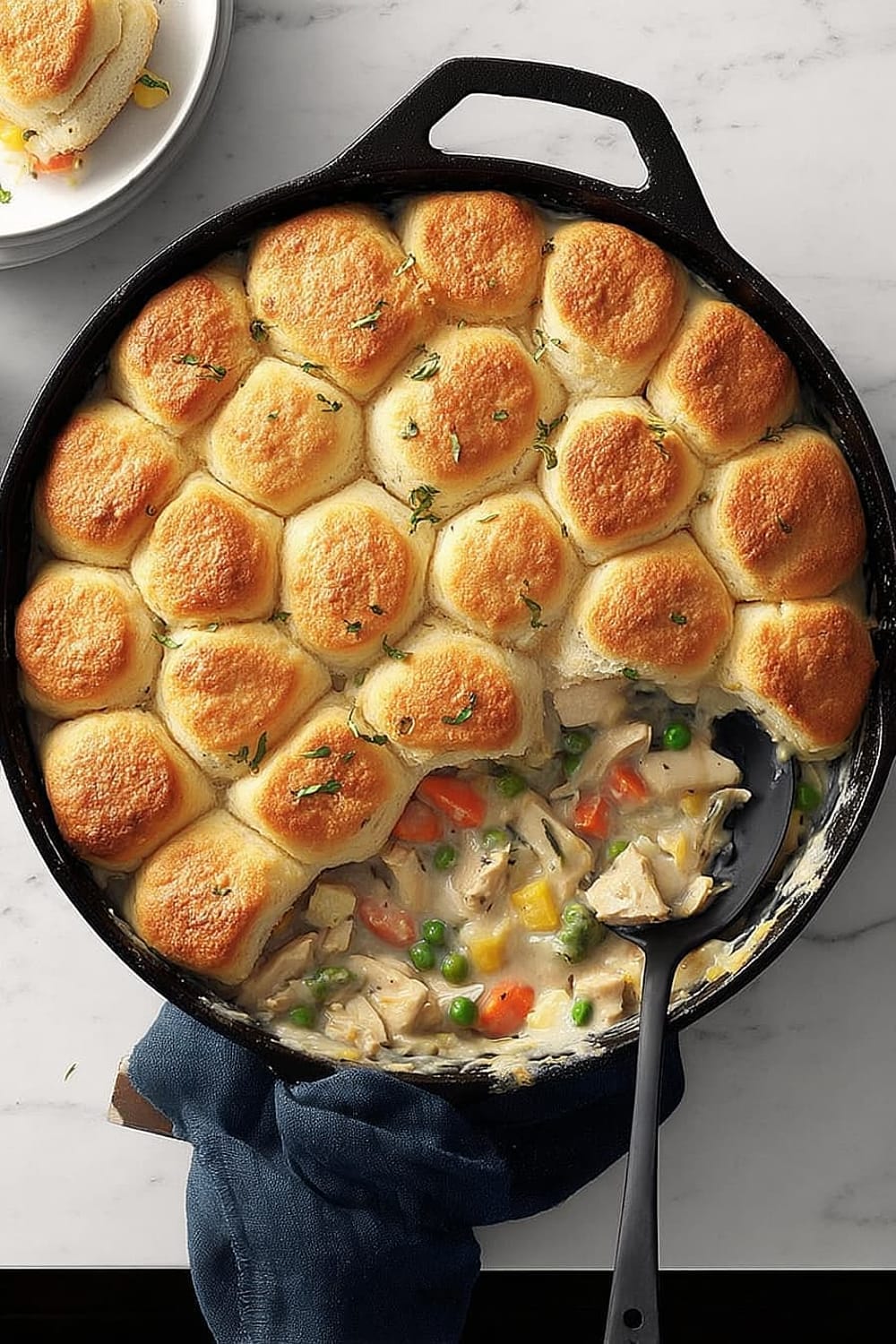
Make It Diabetes-Friendly
Carb Reduction Strategies:
- Replace all-purpose flour with 2 tablespoons almond flour or 1 tablespoon cornstarch to reduce carbs by 15g per serving
- Use sugar-free, low-carb biscuits or substitute with cauliflower florets seasoned with herbs and parmesan cheese
- Increase the turkey and vegetable ratio while reducing biscuit portions to lower overall carb content
Enhanced Nutrition Modifications:
- Add extra fiber with diced bell peppers, mushrooms, or spinach to help slow glucose absorption
- Include 1 tablespoon ground flaxseed in the gravy for added fiber and healthy omega-3 fatty acids
- Use low-sodium chicken broth to better control sodium intake, which is important for blood pressure management
Portion & Timing Tips:
- Serve smaller portions (3/4 cup) alongside a large green salad with olive oil dressing to add healthy fats and fiber
- Estimated carbs per modified serving: Approximately 18-20 grams versus 35 grams in the original
- Pair with protein-rich sides like Greek yogurt or nuts to help stabilize blood sugar response
- Consider having this as a lunch option when you can be more active afterward to help with glucose management
Total Carb Reduction: Modified version reduces carbs by approximately 40-45% compared to the original recipe.
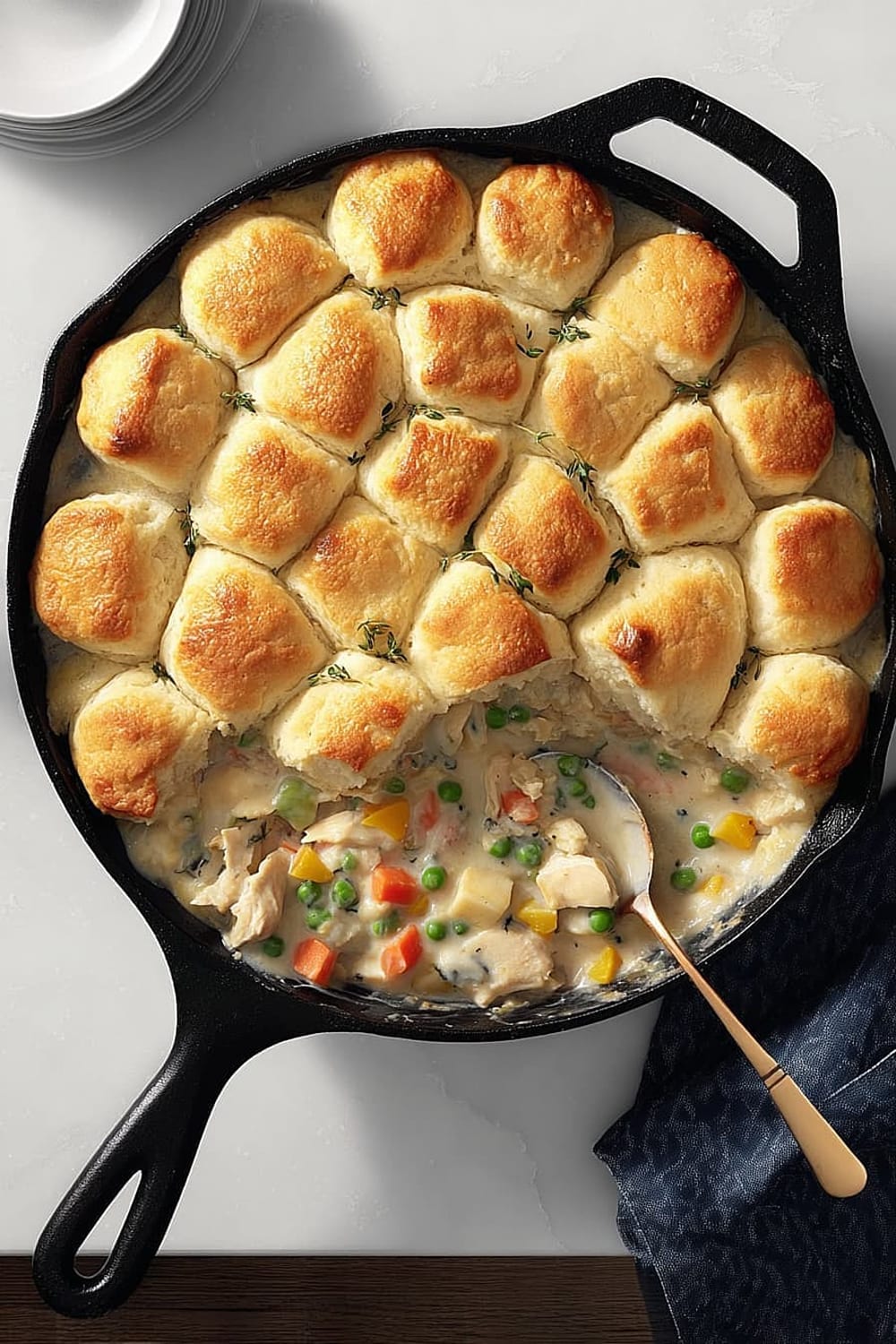
Perfect Pairing Suggestions
Beverage Pairings
A crisp white wine like Sauvignon Blanc or Pinot Grigio complements the creamy, herb-forward flavors without overwhelming the dish. For beer lovers, a light wheat beer or pale ale provides the perfect balance. Non-alcoholic options include sparkling apple cider, iced herbal tea with lemon, or cucumber-infused water for a refreshing contrast to the rich, warming flavors.
Side Dish Recommendations
Fresh arugula salad with lemon vinaigrette cuts through the richness while adding peppery contrast and fresh greens. Roasted Brussels sprouts with bacon bits provide textural variety and complement the comfort food theme. Cranberry sauce or lingonberry preserves add a tart-sweet element that pairs beautifully with turkey. Steamed asparagus with lemon zest offers a light, elegant vegetable side that won’t compete with the hearty skillet.
Complete Meal Ideas
Start with a warm butternut squash soup for a cozy autumn dinner, followed by this skillet as the main course. For entertaining, serve alongside honey-glazed carrots and dinner rolls for a complete comfort food feast. Apple crisp or pumpkin pie makes an ideal dessert that continues the homestyle theme while providing seasonal flavors that complement the savory turkey.
Occasion Suggestions
Perfect for Sunday family dinners, post-holiday leftover meals, cozy weeknight dinners, and casual entertaining. This dish shines during fall and winter months when comfort food cravings peak, and works beautifully for potluck gatherings since it travels well in the cast iron skillet.
Pro Tips and Troubleshooting
Professional Techniques
Always thaw your frozen vegetables completely and pat them dry with paper towels to prevent excess moisture from thinning your gravy. When whisking the flour mixture, use room temperature milk to prevent the mixture from seizing up when it hits the hot skillet. Quarter your biscuits uniformly so they cook at the same rate – uneven pieces will result in some being overdone while others remain doughy.
Common Mistake Prevention
Never add flour directly to the hot skillet without mixing it with liquid first, or you’ll get lumpy gravy that’s nearly impossible to smooth out. If your gravy does get lumpy, strain it through a fine-mesh sieve before adding the turkey and vegetables. Don’t overcrowd the biscuit topping – leave space between pieces for proper expansion and browning.
Storage and Reheating
Store leftovers in the refrigerator for up to 3 days in airtight containers. Reheat individual portions in the microwave at 50% power to prevent the biscuits from becoming tough. For larger portions, cover with foil and reheat in a 300°F (150°C) oven for 15-20 minutes until heated through.
Make-Ahead Strategy
Prepare the turkey stew base up to 24 hours ahead and store covered in the refrigerator. When ready to serve, reheat the base in your skillet, add fresh quartered biscuits, and bake as directed. Scaling tip: This recipe doubles perfectly – just use a larger cast iron skillet or divide between two smaller ones.
This Turkey Biscuit Skillet proves that the best comfort food doesn’t require complicated techniques or expensive ingredients – just quality basics prepared with care and served with love. Whether you’re using up holiday leftovers or creating a cozy weeknight dinner from scratch, this one-skillet wonder delivers maximum satisfaction with minimal effort, making it destined to become a regular rotation recipe in your household.